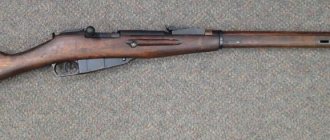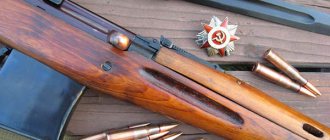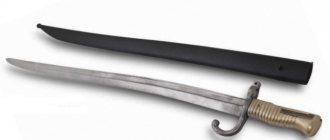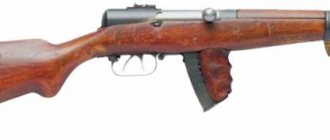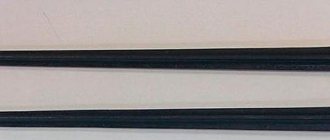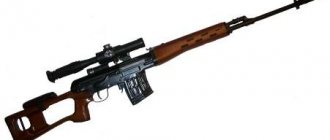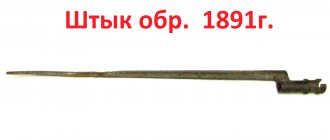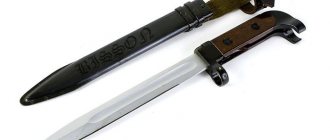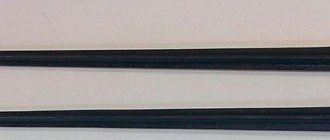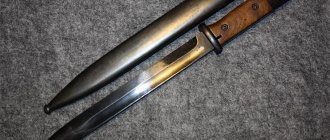At the beginning of the 20th century, especially in the thirties, many designers tried to create an automatically reloadable rifle. Such a task, with the current development of technology, is not difficult, but at that time it was task number one. Accelerating the targeted shooting of a soldier was the main task of the developers of those times. The Tokarev rifle turned out to be a successful option. But we will not talk about it, but about the main accessory of all long-barreled firearms - the SVT-40 bayonet.
Bayonet "SVT-40".
Historical reference
In those years, not without reason, it was believed that bayonet fighting remained a mandatory component when meeting the enemy “face to face.” Accordingly, when manufacturing the firearm itself, the designer had to think about the configuration of the bayonet-knife.
The first rifle presented by F.V. Tokarev, was called SVT-38 (Self-loading Tokarev Rifle). It showed itself worthy, and it was accepted into service, but a year later.
Using the experience of creating bayonet knives for other firearms, she received a relatively long version of the blade. Its length was 36 cm, the heel, handle and blade itself were 2.8 cm thick. The product was made on the basis of the ASV-36 blade.
Thus, the new version has adopted quite a few characteristics from its predecessor.
The photograph shows soldiers with Tokarev SVT-38 rifles.
If we compare the stories of other bayonet knives and rifles made a couple of decades earlier, one interesting feature can be traced. It consisted in the need to always carry the product loaded on the gun, and remove it only when necessary. Now everything has become the other way around, and the SVT-38 rifle was equipped with a bayonet and scabbard .
It did not enter service immediately, but in 1939, after all the necessary tests had been carried out. It was manufactured on the territory of the USSR, at various weapons factories throughout the country. All products were branded and numbered. This applies to both rifles and bayonets.
After several months of using it, minor shortcomings emerged. Which immediately corrected and released into the world the new modernized SVT-40 rifle. A knife of the 1940 model was accepted along with it. It is clear that the number “40” indicates the year of production.
The most important task of modernization was to reduce the weight and size of the product.
Tokarev rifle "SVT-40".
Having shortened the rifle itself, the automation began to malfunction. Therefore, the first step was to shorten the bayonet. It became shorter to 36 cm, and the blade was 24 cm, and also lost up to 0.5 kg in weight.
And the fastening button received a small protective cover. Since it was noticed that during the battle the enemy could hit the bayonet area and hit the latch button, and there were cases of the knife unfastening. The soldier remained unarmed.
SVT. Difficult fate
Footage from old newsreels... An inquisitive eye will always find something interesting in them. Churchill is walking along the Soviet honor guard. Obviously, he flew to the Yalta conference. In the hands of the Soviet soldiers, frozen like statues, are rifles with a characteristic protective casing on the barrel, an unusual muzzle brake and a wide bladed bayonet. Churchill was noticeably pleased with the brave appearance of the Russian soldiers. Another story. Crimea 1942, a Soviet sailor before an attack attaches a bladed bayonet to exactly the same rifle. And here is a completely unusual shot. A German soldier sits holding the same rifle. A German soldier smiles...
So what kind of weapon is this that could be at the same time beautiful in a parade formation, reliable in a soldier’s trench and so valuable that a German soldier might be interested in it?
War veterans and weapons specialists, of course, understood what kind of rifle we were talking about. This rifle is SVT-40 - a Soviet 7.62-mm self-loading rifle of the Tokarev system mod. 1940. So why didn’t it become a “victorious weapon” in that war, like, for example, the rifle mod. 1891/30 or PPSh submachine gun?
SVT has a difficult and dramatic fate. This is not just an example of small arms of the Red Army. The Tokarev rifle was assigned a special role - to become the world's first self-loading rifle, which was supposed to completely replace the usual repeating rifle in the army.
In the world, including in Russia, interest in a self-loading rifle appeared at the beginning of the 20th century. V. G. Fedorov, when developing the automatic weapons of his system, focused specifically on a self-loading rifle chambered for domestic 7.62 mm cartridges mod. 1891/08, and only by 1916 he converted it into a 6.5 mm machine gun.
Meanwhile, in the West, a number of quite successful samples of self-loading Browning rifles mod. 1918 (USA), Mondragon arr. 1908 (Mexico), RSC arr. 1917 (France). However, these models were not so successful that they could equip the entire army.
In Russia, the development of self-loading rifles continued after the Civil War. The first competition to create a self-loading rifle was announced in 1926, to which only 3 samples of rifles were put up - V. G. Fedorov and V. A. Degtyarev.
Then two more competitions were held in 1928 and 1930, and 10 systems of self-loading rifles of the Degtyarev and Tokarev systems were already put up for the 1930 competition, but not a single one of them was recognized as suitable for arming the army.
Such frequent holding of competitions testifies to the unflagging attention to “self-loading” both on the part of the leadership of the Red Army and on the part of the USSR government.
In 1927, a new direction in the development of individual automatic weapons emerged in the USSR - the first domestic submachine gun appeared. The rivalry between these types of automatic weapons - a self-loading rifle and a submachine gun - subsequently determined the appearance of the armament system of the world's armies with individual automatic small arms. It should be noted here that in the late 20s - early 30s, the submachine gun did not receive recognition in the USSR...
In 1931, the young designer S. G. Simonov developed a rather successful automatic rifle - ABC. The rifle was distinguished by its original design of components and mechanisms, a large-capacity magazine (15 rounds), and a neat appearance. ABC used an unusual for domestic practice, but practical and universal blade bayonet. The combination of the combat characteristics of the rifle, together with the fairly high service life of the weapon (27,000 rounds), served as sufficient grounds for adopting the rifle for service. Tactically, the Simonov automatic rifle was significantly superior to the three-line rifle. A shooter with ABC could achieve the same density of fire as a group of 3 or 5 shooters armed with Mosin rifles.
From top to bottom: Experimental Tokarev rifle of 1936.
Self-loading rifle Tokarev SVT-38. Self-loading rifle Tokarev SVT-40. Automatic rifle Tokarev AVT-40. In 1936, under the symbol ABC-36, the rifle was adopted by the Red Army. In total, about 66,000 rifles were produced.
But, despite the obvious advantages over the Mosin rifle, the disadvantages of the ABC were also obvious. These include the complexity of the manufacture and design of the rifle, sensitivity to the quality of steels, the general unreliability of the design when working in critical conditions (dust, frost), and the ineffectiveness of automatic fire at a distance of over 150 m.
At the end of May 1938, a new competition was announced for the development of a self-loading rifle. In the tactical and technical requirements for development, signed by the Chief of the General Staff, General B.M. Shaposhnikov, it was stated, “... the rifle should weigh no more than 4.5 kg... be simple in design, easy to handle and care for, reliable... have high survivability. Its mechanisms should not fail under any atmospheric conditions, despite dirt and thick grease...” Very stringent requirements. The designed automatic weapon with reloading mechanisms and a ten-round magazine was supposed to weigh the same as the obviously simpler magazine rifle mod. 1891/30, the magazine capacity of which is half that. Designers Tokarev, Rukavishnikov and Simonov took part in the competition. The result of the tests is that not a single rifle fully satisfies the conditions of the competition, but the best of those presented is the Tokarev rifle. New tests are scheduled for November 1938. Once again Tokarev takes first place and on 02/26/1939 his self-loading rifle is adopted by the Red Army under the name “7.62-mm Tokarev self-loading rifle mod. 1938 (SVT-38)." The Simonov rifle (SVS) turned out to be much more economically profitable than the SVT, although it was inferior to the latter in terms of the service life of individual parts. But here’s the paradox: it was the SAF that was considered desirable for adoption as the main model of a self-loading rifle, after appropriate modifications.
And again the tests, and the Simonov rifle successfully passes them. But the fate of the rifles had already been decided - without waiting for the results of the latest tests, the Tokarev rifle was put into production - so great was the desire to rearm the Red Army with self-loading rifles. The first SVT-38 rifle was released on July 16, 1939, and in October 1939 their general production began. TOZ was the first to master the production of SVT, and since 1940, the Izhevsk Arms Plant.
Captured SVTs were widely used in the Finnish army. The picture shows Finnish soldiers with SVT-38 (in the foreground) and SVT-40
According to the results of the Soviet-Finnish war of 1939-40. and extensive testing, a number of changes were made to the design of the SVT-38. The rifle was significantly lightened - from 4.9 kg to 4.63 kg (with bayonet), a shortened bayonet was adopted for it. 04/13/1940 The People's Commissariat of Defense of the USSR adopted a resolution on the adoption and start of production of the modernized SVT rifle mod. 1940, along with the simultaneous curtailment of the release of the rifle mod. 1891/30. In the same year, based on the SVT-40, a self-loading sniper rifle was developed and went into production, which differed from the standard SVT in the quality of the barrel bore and the presence of an optical sight on a special bracket. By the way, the optical sight of the PU system mod. 1940 was developed specifically for the SVT sniper. Lightweight, very durable, with excellent characteristics, this optical sight has won universal recognition. In 1942, in a slightly modernized version, the PU brand sight completely replaced the standard PE brand optical sight on sniper rifles mod. 1891/30. The PU sight turned out to be such a successful example of an optical sight that it is still produced under the designations T-3 and PO 3.5×24 (hunting version). In 1940, the production of sniper rifles mod. 1891/30 was discontinued.
Several types of optical sight mounts have been developed for the rifle. On the left is an experimental Tokarev rifle from 1936 with an optical sight. On the right is a serial SVT-40 in sniper version
The production of SVT has been continuously increasing. Before the start of World War II, about two million self-loading cartridges were manufactured. For example, in 1941 alone, the production of SVTs amounted to 1,031,861 units; in 1942, another 2 million rifles were planned for production. By the beginning of the war, SVT were available in sufficient quantities and were mastered by the troops.
Finnish sniper with a captured SVT-40
The effectiveness of Soviet self-loading rifles was evident in the very first battles. The Germans often mistook fire from these rifles for machine gun fire. During the siege of the Brest Fortress, German infantry could not get within range of their submachine guns until the defenders ran out of ammunition. To counter rifle fire, German infantry units were forced to bring up artillery!
Soviet self-loading rifles were distinguished by good shooting accuracy. The Nazis, not having such weapons, assembled them on the battlefield and, after appropriate repairs and debugging, armed their snipers and fighters of the counter-partisan “yagd teams” (detachments of hunter-saboteurs) with them. German soldiers considered it a great success to obtain Russian self-loading guns in battle. But not only that, the Nazis officially adopted the SVT into service with the Wehrmacht, assigning it the index “model 453R”. It is no secret that all warring armies in some cases use enemy weapons, but do not officially accept them for service. The adoption of an enemy weapon means not only a high assessment of its combat properties, but also an admission of the fact that one’s own industry is incapable of producing something similar. That's how it really was. German self-loading rifles G-41(M) and G-41(W) turned out to be clearly unsuitable for use in the army.
During World War II, Tokarev rifles were also popular in the Wehrmacht.
The picture shows a German officer with an AVT-40 rifle (Stalingrad, 1942) At the end of 1941, alarming signals began to come from the front - the SVT is unreliable, gives a large percentage of delays, is sensitive to pollution and dust, and “freezes” in the cold.
The accuracy of combat of sniper SVTs was considered insufficient and inferior to the accuracy of combat of a sniper rifle mod. 1891/30. The SVT safety box was located behind the trigger, and for the AVT-40 it was also a fire mode translator.
And immediately, without much explanation of the reasons, the production of the SVT was sharply reduced. Thus, compared to 1941, in 1942 the production of rifles fell 5 times. At the beginning of 1942, the production of three-line sniper guns was restored, and on October 1, 1942, the production of sniper SVTs was discontinued. But it was impossible to completely stop the production of SVT - there was a serious shortage of automatic weapons in the troops. Due to the lack of submachine guns and light machine guns in the troops, on May 20, 1942, the State Defense Committee adopted a resolution on the production of Tokarev automatic rifles (AVT).
Reports from the troops noted that the AVT does not provide the necessary accuracy of fire and the strength (survivability) of parts. Dangerous defects appeared, such as rupture and failure to remove spent cartridges, under-opening of the bolt, and misfires. The production of SVT and AVT continued to decline, and on January 3, 1945, the USSR State Defense Committee issued a decree on discontinuing production of SVT and AVT rifles (only two weeks earlier than a similar decree on rifles model 1891/30). After the war, the remaining SVTs were withdrawn from the troops and put into warehouses. SVT remained in service only in the honor guard company: thus becoming a purely ceremonial weapon. Although it was an honorable resignation, it was still a resignation. This, in general, ingloriously ended the combat history of the SVT.
Why did it happen that the SVT, which adequately passed such severe tests as the war on the Karelian Isthmus and the hardest months of the first year of the Great Patriotic War, could not ultimately live up to the hopes placed on it?
Muzzle devices of Tokarev rifles of different models (from top to bottom): experimental rifle of 1936, SVT-38, AVT-40. The shape of the muzzle device of the SVT-40 rifles of later releases was the same as that of the AVT-40
Most literary sources, including such authoritative ones as D. N. Bolotin’s book “Soviet Small Arms,” suggest that the low reliability of both self-loading and automatic Tokarev rifles is explained by the use of domestic 7.62-mm rifles for firing from them cartridge. It is said that the cartridge has a protruding flange, large dimensions, high power and its use does not allow creating a reliable self-loading rifle. This is an obvious mistake. That's not the point at all. Our rifle cartridge is not the most powerful or largest of contemporary rifle cartridges. The protruding flange of a rifle cartridge casing makes it difficult to design a weapon, but a properly designed magazine completely eliminates its influence on the operation of the weapon’s automation. The protruding flange of the same cartridge does not interfere with shooting from another domestic self-loading rifle - SVD.
The reasons for the failure of a self-loading rifle are different. The main thing is the incorrect, sometimes clearly illiterate operation of the rifle, the inevitable decline in the quality of the rifles during the war, as well as the implementation of a number of erroneous decisions regarding the operation of the SVT and which undermined its reputation as a reliable weapon.
A self-loading rifle, like any other automatic weapon, requires obviously more careful attention than a simple repeating rifle. In the first months of the war, most of the rank and file of the Red Army, who knew how to competently operate SVT, died or were captured. Most of the older soldiers who replaced them from the reserve did not understand both the structure of the rifle and the need to carefully monitor it, take care of it, and follow the rules and regime of cleaning and lubrication (this problem is relevant in the army even today). The quality of the lubricants themselves also left much to be desired. Hence the “sticking” of moving parts in the cold. The weapon required the use of high-quality, especially frost-resistant lubricants, but they were not available.
Details of partial disassembly of CBT-40
Parts of the gas engine of the SVT-40 rifle
The adoption of the SVT sniper rifle as the main model of the Red Army sniper rifle was generally a very controversial decision.
You cannot expect accuracy from an automatic weapon comparable to that of a non-automatic weapon. Even the modern specially designed self-loading sniper rifle SVD is inferior in accuracy to the sniper rifle mod. 1891/30. Moreover, it will be inferior to the SVT, which has a completely “non-sniper”, non-rigid design and an asymmetrical locking unit. But, losing to the rifle mod. 1891/30, within the range of effective sniper shooting, a sniper armed with SVT received an invaluable opportunity to quickly fire a second aimed shot and hit (finish off) a target not hit by the first shot. The gross SVT at ranges up to 600 m had quite decent accuracy of fire, not inferior to the carbine mod. 1938 Polish Army soldier with a late-release CBT-40 rifle (the muzzle device is similar to the ABT-40, but the rifle magazine is designed for 10 rounds)
The decision to produce the SVT in an automatic version (AVT) finally undermined the authority of self-loading. The rifle's receiver is not adapted to withstand powerful cyclic loads; it was simply deformed when firing in bursts - hence the ruptures of the cartridges and the under-opening of the bolt. Obviously, the troops abused the automatic fire mode, which in the service manual for automatic fire is called “an auxiliary type of fire conducted when there is a lack of light machine guns and in exceptional moments of the battle...”.
Not the least role in reducing the reliability of SVT was played by the decreased quality of their manufacture. The design did not have a strength reserve to compensate for wartime production costs - primarily due to the very strict weight restrictions built into its design during development.
Of course, one cannot discount the rifle’s own shortcomings – the possibility of losing the magazine, the inconvenience of disassembling the weapon and gas adjustment, and sensitivity to contamination of the receiver cavity. All these “everyday” shortcomings of the weapon were not irreparable and could well have been eliminated during production. By the way, some of them have been eliminated - for example, the gas regulator assembly has been simplified. But it was too late - confidence in the self-loading rifle was completely lost.
A new attempt to introduce a self-loading weapon into service with the army in 1945 - the SKS carbine chambered for mod. 1943 ultimately also ended in failure.
Combat tests of the carbine were successful, and the troops liked the weapon. But by that time, the first samples of machine guns had already been developed, combining the fire density of a submachine gun with the power of a mod cartridge. 1943 For machine guns, the focus was not on accuracy, but on the density of fire.
The Kalashnikov assault rifle, which entered service with the army, coexisted for some time in the troops along with the SKS carbine, as if competing to see which of them was better. As a result, the AK won - and became a symbol of Soviet weapons, and the SKS, like the SVT before it, was discontinued and later removed from the weapons system. The SKS exactly repeated the fate of the SVT, becoming the standard ceremonial weapon of the Soviet Army.
This is how the self-loading rifle ended its existence in our army as a type of individual weapon for the infantryman. The tragic fate of the SVT gave our army and weapons science a harsh but invaluable lesson - an automatic weapon for a Russian soldier should be very simple, extremely unpretentious, as reliable as possible and extremely durable. The only way. Our soldier will not accept another weapon and, sad as it may sound, will destroy it. This is not to say that the SVT is an unreliable weapon. This rifle was ruined by its excessive sensitivity to both the slightest changes in the production process and the qualifications of the shooter using it. This, apparently, lies the mystery of the popularity of SVT among enemy troops, where it was used much more competently. This made it possible to smooth out the inherent shortcomings of the SVT and maximize all the best qualities inherent in the design of the Russian
At the end of the 50s, Interarmco purchased a large number of various weapons from Finland, including Tokarev rifles, for sale on the US domestic market. The illustration shows an advertisement often found in American gun magazines in the early 60s.
However, the fate of the Tokarevskaya SVT is still not as sad as it might seem at first glance. Our beauty - self-loading SVT is held in high esteem abroad - in the USA and, especially, in Finland, where it is known from the war of 1939-40. and are very much appreciated. Finnish experts are still surprised how such, in their words, an excellent weapon, did not receive recognition in the Red Army, and perceive any criticism of the SVT as blasphemy.
Sometimes SVT can be found among weapon collectors and hunters. Such a rifle, if it is in good condition, is expensive, they take care of it, they are proud of it, preferring it to other (even modern and imported) weapon systems of a similar class for convenience, reliability and a number of individual features that make the SVT an excellent hunting weapon.
And one last thing. Recently, one of the repair enterprises of the Russian Defense Ministry received an order to prepare a large batch of sniper military equipment for sale abroad. So, perhaps, soon a new life will begin for the old Soviet self-loading SVT, only, unfortunately, far from our country.
Tactical and technical characteristics of Tokarev self-loading rifles:
* Initial speed when firing a light bullet m = 9.6 g. ** Combat rate of fire of the AVT rifle when firing in bursts. *** Weight of magazine with cartridges.
Ruslan Chumak
Design
To date, the blade is not in service with any country. And it turned into a historical heritage. Its design features were as follows:
The handle of the SVT-40 bayonet.
- wooden cheeks with rivets form a handle, it is straight without anatomical features;
- the handle has a T-shaped groove and a spring latch with a button;
- the button is covered on one side with a collar;
- The blade is sharpened on one side, straight, and has two fullers over almost the entire surface. Closer to the tip there is a double sharpening;
- straight cross made of steel, the ring is located on the side of the butt (diameter 14mm);
- on the heel of the handle there is a manufacturer's mark;
- metal sheath with brackets for hanging.
Over several years, about 1.6 million weapons were produced. In several modifications.
Bayonet, model 1940, for Tokarev rifles SVT-40/AVT-40
Description The Soviet-Finnish war revealed a number of design flaws in the SVT-38 rifle. In 1940, a modernized version of the Tokarev system rifle of the 1938 model was adopted into service with the Red Army. called SVT-40, and in 1942 the next generation of this rifle, AVT-40, was put into service. The same type of bayonet known as the SVT-40 bayonet was used with both of these rifles.
The 1940 model bayonet is a shortened analogue of its predecessor, the 1938 model. The bayonet became shorter by as much as 12 cm, and the width of the blade also changed by 3 mm. In addition, the shape of the groove in the head of the handle was slightly changed and a safety collar was added to the spring latch button.
SVT-40 bayonets were produced at three enterprises: at the Tula Arms Plant (stamp in the form of a five-pointed star), at the Izhevsk Machine-Building Plant (stamp in the form of an arrow in a triangle), at the Kovrov Mechanical Plant (stamp in the form of an arrow in an oval).
The bayonet blade is single-edged, with a fuller on both sides, available with or without blued finish.
The handle is formed by two wooden cheeks, fastened to the shank with two screws. The head of the handle has a T-shaped groove and a spring latch with an internal spiral spring, and the spring latch button has a safety collar. The cross is straight with a ring for the barrel.
The sheath is steel, with two belt clips. The sheath of the first releases is similar to the sheath of the SVT-38 bayonet with a change in size downward.
Leather or canvas hanging strap.
All SVT-40 bayonets are divided into two large groups: “upper sharpening,” also known as type-1, and “lower sharpening,” also known as type-2. Bayonets of the first type (upper sharpening) are earlier in the year of manufacture and inherited the sharpening on the ring side from its predecessor SVT-38. Also, bayonets of the first type often do not have a protective safety collar near the spring latch button. On the heel of the blade there is a bayonet number that matches the rifle number.
Bayonets of the second type (lower sharpening) are later in the year of production and already have a traditional sharpening of the blade on the side opposite to the ring. The bayonet number is stamped on the wooden handle and does not correspond to the rifle number.
There is a version that bayonets of the 1940 model were not blued in the Soviet Union, and if the SVT bayonet is blued, then it was in service in one of the Warsaw Pact countries (most likely Bulgaria) after World War II. Also, one of the signs that the bayonet left the USSR after World War II is the bayonet number engraved on the cross.
Total length: 360 mm
Blade length: 240 mm
Blade width: 24 mm
Inner diameter of the Ring in the cross: 14 mm
Modifications
In addition to the key modifications of the 38th and 40th years, additional variants of rifles and carbines were also produced. This was a sniper version of the SVT-40 and an automatic version of the AVT-40, and an automatic carbine AKT-40. As far as we know, only AVT-40 knives were equipped with knives. In the end, it turned out that there were more carbines and rifles than knives.
Sniper version "SVT-40".
Specifications
The SVT-38 bayonet has different characteristics than the 1940 blade. But since the product of a newer version has gained greater fame and popularity, let’s consider its characteristics:
- total length is 36 cm;
- the blade itself is 24 cm long;
- blade width - 2.4 cm;
- ring in the cross - 1.4 cm;
- handle width, about 2.4 cm;
- weight, after the latest modernization - 0.425 kg.
After the end of World War II, many rifles were disposed of or converted for civilian use.
The possibility of installing a bayonet and small parts were removed. People enjoyed going hunting with them.
Previous
KnivesKnife for fishing: types and rating of the best models and manufacturers
Next
National knivesEvenki knife - Siberian folk tool
SVT40 bayonet scabbard (replica)
Policy regarding the processing of personal data 1. General provisions This policy for the processing of personal data is drawn up in accordance with the requirements of the Federal Law of July 27, 2006. No. 152-FZ “On Personal Data” and determines the procedure for processing personal data and measures to ensure the security of personal data milrec.ru (hereinafter referred to as the Operator). The operator sets as its most important goal and condition for carrying out its activities the observance of the rights and freedoms of man and citizen when processing his personal data, including the protection of the rights to privacy, personal and family secrets. This Operator’s policy regarding the processing of personal data (hereinafter referred to as the Policy) applies to all information that the Operator can obtain about visitors to the website https://milrec.ru/.
2. Basic concepts used in the Policy Automated processing of personal data – processing of personal data using computer technology; Blocking of personal data – temporary cessation of processing of personal data (except for cases where processing is necessary to clarify personal data); Website – a collection of graphic and information materials, as well as computer programs and databases that ensure their availability on the Internet at the network address https://milrec.ru/; Information system of personal data - a set of personal data contained in databases, and information technologies and technical means that ensure their processing; Depersonalization of personal data - actions as a result of which it is impossible to determine without the use of additional information the ownership of personal data to a specific User or other subject of personal data; Processing of personal data – any action (operation) or set of actions (operations) performed using automation tools or without the use of such means with personal data, including collection, recording, systematization, accumulation, storage, clarification (updating, changing), extraction, use, transfer (distribution, provision, access), depersonalization, blocking, deletion, destruction of personal data; Operator - a state body, municipal body, legal or natural person, independently or jointly with other persons organizing and (or) carrying out the processing of personal data, as well as determining the purposes of processing personal data, the composition of personal data to be processed, actions (operations) performed with personal data; Personal data – any information relating directly or indirectly to a specific or identified User of the website https://milrec.ru/; User – any visitor to the website https://milrec.ru/; Providing personal data – actions aimed at disclosing personal data to a certain person or a certain circle of persons; Dissemination of personal data - any actions aimed at disclosing personal data to an indefinite number of persons (transfer of personal data) or familiarizing with personal data to an unlimited number of persons, including the publication of personal data in the media, posting in information and telecommunication networks or providing access to personal data in any other way; Cross-border transfer of personal data – transfer of personal data to the territory of a foreign state to an authority of a foreign state, a foreign individual or a foreign legal entity; Destruction of personal data – any actions as a result of which personal data are destroyed irrevocably with the impossibility of further restoration of the content of personal data in the personal data information system and (or) as a result of which the material media of personal data are destroyed.
3. The Operator may process the following personal data of the User Last name, first name, patronymic; Email address; Phone numbers; postal details (zip code, address); The site also collects and processes anonymized data about visitors (including cookies) using Internet statistics services (Yandex Metrica and Google Analytics and others). The above data below in the text of the Policy are united by the general concept of Personal Data.
4. Purposes of processing personal data The purpose of processing the User’s personal data is to inform the User by sending emails; providing the User with access to services, information and/or materials contained on the website; clarification of order details, data for postal or other transport or courier delivery. The Operator also has the right to send notifications to the User about new products and services, special offers and various events. The User can always refuse to receive information messages by sending the Operator a letter to the email address [email protected] with the note “Opt-out of notifications about new products and services and special offers.” Anonymized data of Users, collected using Internet statistics services, serves to collect information about the actions of Users on the site, improve the quality of the site and its content.
5. Legal grounds for processing personal data The Operator processes the User’s personal data only if it is filled out and/or sent by the User independently through special forms located on the website https://milrec.ru/. By filling out the appropriate forms and/or sending his personal data to the Operator, the User expresses his consent to this Policy. The Operator processes anonymized data about the User if this is allowed in the User's browser settings (saving cookies and using JavaScript technology are enabled).
6. The procedure for collecting, storing, transferring and other types of processing of personal data The security of personal data processed by the Operator is ensured by implementing legal, organizational and technical measures necessary to fully comply with the requirements of current legislation in the field of personal data protection. The operator ensures the safety of personal data and takes all possible measures to prevent access to personal data by unauthorized persons. The User's personal data will never, under any circumstances, be transferred to third parties, except in cases related to the implementation of current legislation. If inaccuracies in personal data are identified, the User can update them independently by sending a notification to the Operator to the Operator’s email address marked “Updating personal data.” The period for processing personal data is unlimited. The User may at any time withdraw his consent to the processing of personal data by sending a notification to the Operator via email to the Operator's email address marked “Withdrawal of consent to the processing of personal data.”
7. Cross-border transfer of personal data The operator, before starting the cross-border transfer of personal data, is obliged to make sure that the foreign state to whose territory it is intended to transfer personal data provides reliable protection of the rights of the subjects of personal data. Cross-border transfer of personal data to the territory of foreign states that do not meet the above requirements can only be carried out if there is written consent of the subject of personal data to the cross-border transfer of his personal data and/or execution of an agreement to which the subject of personal data is a party.
8. Final provisions The User can receive any clarification on issues of interest regarding the processing of his personal data by contacting the Operator via email. This document will reflect any changes in the Operator’s personal data processing policy. The policy is valid indefinitely until it is replaced by a new version. The current version of the Policy is freely available on the Internet at https://milrec.ru/page/Soglasie-na-obrabotku-personalnyh-dannyh.
